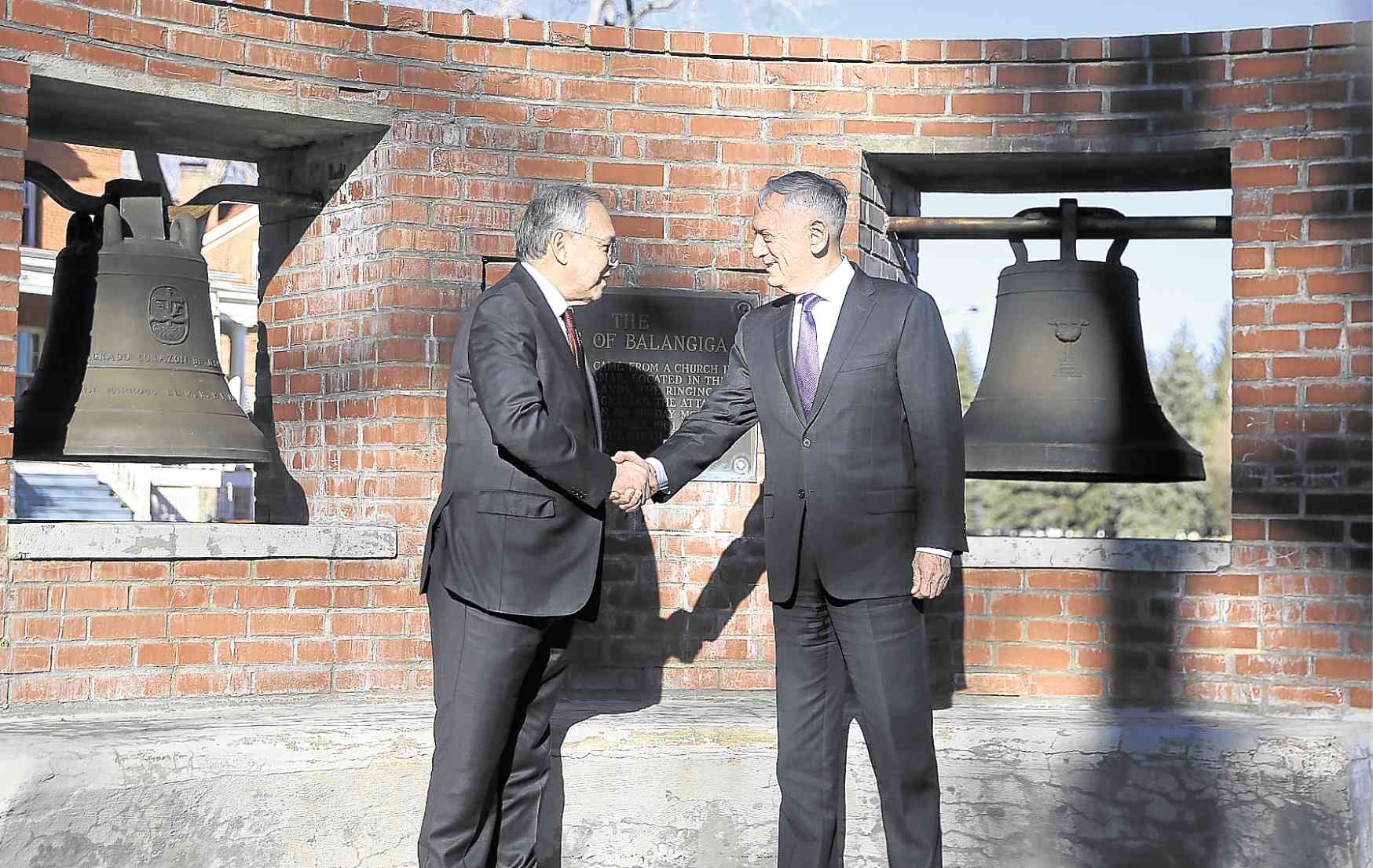
BOLSTERING FRIENDSHIPPhilippine Ambassador to the United States Jose Manuel G. Romualdez (left) and US Defense Secretary James Mattis agree that the return of the bells of Balangiga to the Philippines will deepen respect and bolster relations between the longtime allies. —AP
F.E. WARREN AIR FORCE BASE, WYOMING—US Defense Secretary James Mattis on Wednesday formally returned church bells to the Philippines that were taken as war trophies over a century ago following gruesome clashes, seeking to close a contentious chapter in the two allies’ shared history.
The decision to return the bells of Balangiga ends a decadeslong quest by Manila and is expected to bolster US-Philippines relations.
But the move has upset some US veterans and Wyoming’s all-Republican delegation to the US Congress, who opposed returning bells that were a memorial to the 48 US soldiers who were killed in Balangiga town, Eastern Samar province, during the American occupation of the Philippines.
Filipinos revere the bells as symbols of national pride and Philippine leaders, including President Duterte, have repeatedly called for their return.
‘Long overdue victory’
Former Senate President Aquilino “Koko” Pimentel III said their imminent return was a “long overdue victory for the Filipino people.”
Pimentel said the return of the bells was especially significant at this time, “considering our continually evolving relationship with the US these last two years” after President Duterte took office.
Duterte has been critical of the United States while cozying up to China, which has promised investments, loans and other aid.
Mattis called the controversial decision to repatriate the bells an important gesture of friendship between the two countries.
Worst rout of US troops
The Sept. 28, 1901, attack in Balangiga was seen as perhaps the worst rout of US soldiers since the Battle of the Little Bighorn in 1876, also known as Custer’s Last Stand.
According to historians, one or more of the church bells were rung to signal the attack.
US forces took the bells after a brutal counterattack that killed anywhere from hundreds to thousands of Filipinos, historians say. One US general was said to have directed his troops to “make the interior of Samar a howling wilderness.”
Two of the bells are at F.E. Warren Air Force Base in Cheyenne, Wyoming, and the third is at the US Army’s 9th Infantry Regiment base in South Korea.
Visit by Mattis
Mattis marked the start of a weekslong process to return the bells to the church in Balangiga with a visit to the two bells at F.E. Warren. With him was the Philippine ambassador to Washington, Jose Manuel G. Romualdez.
“History reminds us that all wars end. In returning the bells of Balangiga to our ally and our friend, the Philippines, we pick up our generation’s responsibility to deepen the respect between our peoples,” Mattis said in a ceremony at the base.
Soldiers from the Philippines fought alongside US troops in World War II, Korean War, Vietnam War and in the recent struggle against international terrorism, Mattis pointed out.
Mattis said the Philippines had proven itself as a great US ally in conflicts over the century since the Balangiga attack. He said the sacrifices of US forces would not be forgotten.
‘Courage is timeless’
“To those who fear we lose something by returning these bells, please hear me when I say: Bells mark time, but courage is timeless,” Mattis said.
“It does not fade in history’s dimly lit corridors,” he added.
In his speech at the ceremony, Romualdez said “the Philippine government and the Filipino people appreciate this gesture” by the Americans.
“Today is a time of solemn remembrance as we pay tribute to all those who gave up their lives during the Filipino-American War. We also honor the shared sacrifice of Filipinos and Americans who fought shoulder to shoulder during the Second World War,” he said. —WITH REPORTS FROM AP, LEILA B. SALAVERRIA AND JEROME ANING